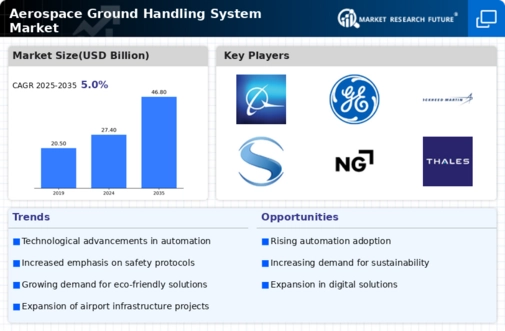Increasing Air Traffic
The Global Aerospace Ground Handling System Market Industry is experiencing growth due to the continuous increase in air traffic. As more passengers opt for air travel, airlines are compelled to enhance their ground handling capabilities to ensure efficiency and safety. In 2024, the market is valued at approximately 27.4 USD Billion, reflecting the industry's response to rising demand. This trend is expected to persist, with projections indicating a market size of 46.8 USD Billion by 2035. The compound annual growth rate of 4.97% from 2025 to 2035 underscores the necessity for advanced ground handling systems to accommodate the burgeoning number of flights globally.
Market Growth Projections
The Global Aerospace Ground Handling System Market Industry is projected to experience substantial growth over the next decade. With a market valuation of 27.4 USD Billion in 2024, it is anticipated to reach 46.8 USD Billion by 2035. This growth trajectory, characterized by a compound annual growth rate of 4.97% from 2025 to 2035, indicates a robust demand for innovative ground handling solutions. Stakeholders are likely to invest in advanced technologies and systems to enhance operational efficiency and meet the evolving needs of the aviation sector. This positive outlook suggests a dynamic and competitive market landscape in the coming years.
Sustainability Initiatives
Sustainability initiatives are becoming increasingly relevant within the Global Aerospace Ground Handling System Market Industry. As environmental concerns grow, airports and airlines are seeking to reduce their carbon footprints through eco-friendly ground handling practices. This includes the adoption of electric ground support equipment and the implementation of waste reduction strategies. The push for sustainability is likely to influence investment decisions, as stakeholders recognize the long-term benefits of environmentally responsible operations. By aligning with global sustainability goals, the industry may enhance its reputation and appeal to environmentally conscious travelers, thereby driving further growth.
Technological Advancements
Technological innovations play a pivotal role in shaping the Global Aerospace Ground Handling System Market Industry. The integration of automation, artificial intelligence, and data analytics into ground handling processes enhances operational efficiency and reduces turnaround times. For instance, automated baggage handling systems and AI-driven resource management tools are increasingly adopted by airports worldwide. These advancements not only streamline operations but also improve safety and reliability. As the industry evolves, the demand for sophisticated ground handling solutions is likely to rise, further propelling market growth and ensuring that stakeholders remain competitive in an ever-changing aviation landscape.
Expansion of Airport Infrastructure
The expansion of airport infrastructure is a crucial driver for the Global Aerospace Ground Handling System Market Industry. As governments and private entities invest in upgrading and expanding airport facilities, the demand for efficient ground handling systems rises correspondingly. New terminals and runways necessitate enhanced ground support services to manage increased passenger and cargo volumes. This trend is particularly evident in emerging markets, where rapid urbanization and economic growth are leading to the construction of new airports. Consequently, the market is poised for growth as stakeholders seek to capitalize on these infrastructure developments to improve operational efficiency and service quality.
Regulatory Compliance and Safety Standards
The Global Aerospace Ground Handling System Market Industry is significantly influenced by stringent regulatory compliance and safety standards imposed by aviation authorities. These regulations necessitate that ground handling service providers adopt best practices to ensure passenger and aircraft safety. Compliance with international standards, such as those set by the International Civil Aviation Organization, drives investment in advanced ground handling systems. As a result, companies are increasingly focusing on upgrading their equipment and training personnel to meet these requirements. This focus on safety and compliance not only enhances operational efficiency but also fosters consumer confidence in air travel.





















Leave a Comment